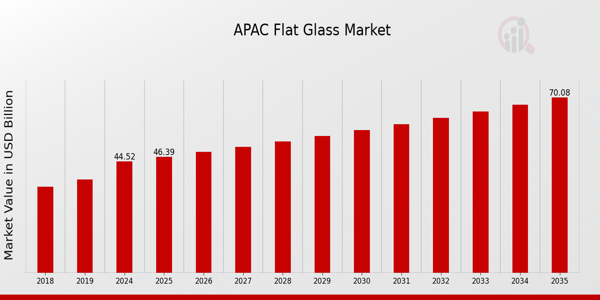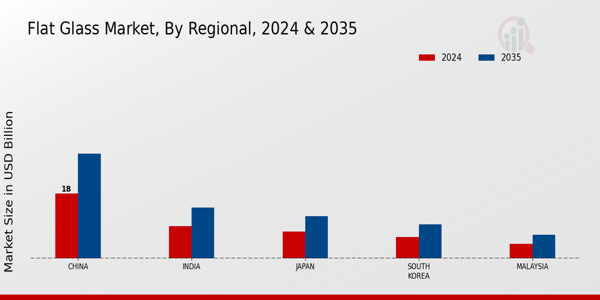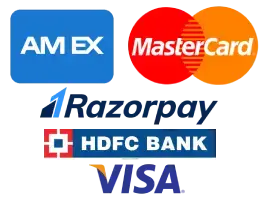APAC Flat Glass Market Overview
The APAC Flat Glass Market Size was estimated at 42.55 (USD Billion) in 2023.The APAC Flat Glass Industry is expected to grow from 44.52(USD Billion) in 2024 to 70.08 (USD Billion) by 2035. The APAC Flat Glass Market CAGR (growth rate) is expected to be around 4.211% during the forecast period (2025 - 2035).
Key APAC Flat Glass Market Trends Highlighted
Accelerated urbanization and industrialization are driving significant trends in the APAC Flat Glass Market. Flat glass, which is extensively employed in infrastructure and structures, is experiencing a significant increase in demand as a result of the substantial growth in construction activities in countries such as China and India. The growing emphasis on sustainable building practices and energy efficiency is stimulating the adoption of energy-efficient glazing solutions. Additionally, the flat glass sector is experiencing innovation as a result of the implementation of stringent regulations by governments in APAC that encourage the use of energy-saving materials.
The APAC Flat Glass Market offers a plethora of opportunities, particularly in the renewable energy sector, where the demand for solar panels is on the rise.Solar energy technologies are being integrated into building materials, which is indicative of a growing trend toward sustainability and functionality. This movement is expected to generate new markets for flat glass manufacturers who specialize in the production of products that satisfy both aesthetic and functional needs. Infrastructure development is also a primary focus of emerging economies in the region, which presents opportunities for flat glass producers to participate in large-scale initiatives.
In recent years, there has been a significant transition to smart glass technology, which improves the user experience by generating energy and self-tinting. This technological advancement suggests a trend in which innovation is in accordance with environmental consciousness, thereby accommodating the changing preferences of both consumers and architects in APAC.In general, the APAC Flat Glass Market is experiencing dynamic growth, which is being influenced by the rapid tempo of infrastructure development, sustainability mandates, and technological advancements.

Source: Primary Research, Secondary Research, Market Research Future Database and Analyst Review
APAC Flat Glass Market Drivers
Increasing Construction Activities in the APAC Region
The APAC Flat Glass Market Industry is poised for significant growth due to the rapid increase in construction activities across countries in the Asia-Pacific region. According to the Asian Development Bank, the construction sector in APAC is expected to grow at an annual rate of 5.1 percent, driven by urbanization and infrastructure development initiatives. Countries like China and India are leading this boom, with China spending over USD 3 trillion on infrastructure projects, including housing, commercial buildings, and transportation infrastructure.
This significant investment in construction is expected to boost the demand for flat glass, particularly in windows, facades, and safety glass applications. Established organizations like Saint-Gobain and AGC Inc. are enhancing their production capacities to meet the increasing demand, thereby further pushing the growth of the APAC Flat Glass Market.
Growing Focus on Energy-efficient Building Materials
The demand for energy-efficient building materials is accelerating within the APAC Flat Glass Market Industry, driven by governmental regulations advocating for sustainable construction practices. For instance, the Green Rating for Integrated Habitat Assessment in India aims to make buildings more sustainable, which has led to an estimated 30 percent increase in demand for energy-efficient glass products.
Furthermore, initiatives in countries like Japan, where energy-efficient retrofitting is encouraged through subsidies, have resulted in a rise in interest for low-emissivity and insulated glass products.Major players in the market, such as Nippon Sheet Glass and Guardian Glass, are focusing on the development of innovative glazing solutions that meet these new energy standards.
Rising Automotive Production in Asia-Pacific
The automotive sector within the APAC region is witnessing robust growth, which is positively influencing the APAC Flat Glass Market Industry. According to the Japan Automobile Manufacturers Association, Japan recorded over 8 million vehicle production units in 2022, along with similar trends in countries like India and China, which are among the largest automotive producers in the world. This growth demands a variety of glass products for automotive applications, such as windshields and side windows, leading to a surge in flat glass consumption.
Reputed automotive glass manufacturers like Fuyao Glass Industry Group and Asahi Glass Company are capitalizing on this trend by increasing their production capacities and expanding their facilities within the region.
APAC Flat Glass Market Segment Insights
Flat Glass Market Product Type Insights
The APAC Flat Glass Market is characterized by diverse product types, which play a crucial role in various applications ranging from construction to automotive. Among these types, Clear Float Glass is notable for its widespread use, as it provides clarity and transparency, making it essential for windows and facades. Tempered Glass, known for its increased strength due to thermal treatment, is increasingly preferred in building safety and automotive sectors, contributing significantly to market growth.
Insulated Glass, designed to improve thermal efficiency in buildings, is gaining prominence as energy efficiency becomes a priority in the industry.Coated Glass, which includes various surface treatments to enhance appearance and performance, addresses diverse requirements in architectural design and aesthetics, thus expanding its market share. Additionally, Laminated Glass offers safety and sound insulation, making it a popular choice in both commercial and residential buildings. Annealed Glass, while less favored for high-stress applications, still holds importance for its basic functions and cost-effectiveness.
This segmented approach in the APAC Flat Glass Market highlights the essential characteristics and applications of each product type, showcasing their contributions to the overall industry while responding to trends like sustainability and energy efficiency.Each type addresses specific consumer needs, thereby fueling continuous demand in the region, which is projected to see significant construction expansion, particularly in developing countries. As urbanization accelerates across APAC, innovation in processing techniques and material properties will further enhance the performance and appeal of these glass products, ensuring a robust future for the market.
Overall, the APAC Flat Glass Market segmentation underscores the vital roles that these various product types play in meeting evolving technological standards and consumer expectations.

Source: Primary Research, Secondary Research, Market Research Future Database and Analyst Review
Flat Glass Market End User Insights
The APAC Flat Glass Market is experiencing robust growth driven by diverse end users such as Building and Construction, Automotive, Consumer Goods, and Solar. Among these, the Building and Construction sector plays a pivotal role, as rising urbanization and high demand for residential and commercial spaces contribute significantly to the predominance of flat glass utilization. In the Automotive sector, innovations in vehicle design and increasing consumer preference for aesthetically appealing cars further drive the demand for flat glass. The Consumer Goods segment also leverages flat glass in appliances and packaging, highlighting its versatility and critical role in day-to-day products.
Meanwhile, the Solar segment is gaining traction due to the growing emphasis on renewable energy sources, with flat glass being integral in photovoltaic applications to increase energy efficiency. Overall, the segmentation in the APAC Flat Glass Market illustrates a dynamic interaction of trends fostering growth. At the same time, challenges such as environmental regulations and competition necessitate adaptability and innovation across all sectors, thereby enhancing market opportunities within the region. The APAC landscape is rich with potential, presenting a fertile ground for the expansion of all mentioned end-user categories within the flat glass market sphere.
Flat Glass Market Regional Insights
The APAC Flat Glass Market exhibits a dynamic and multifaceted landscape characterized by significant contributions from various regions, primarily driven by rapid urbanization and increasing construction activity. China is a pivotal player, dominating the market due to its expansive manufacturing capabilities and substantial demand for glass in the architecture and automobile industries. India follows closely, with its burgeoning population and infrastructure projects fueling growth, positioning it as a key player in the market.
Japan plays an essential role as well, leveraging advanced technology and sustainable practices to enhance its glass production processes.South Korea’s market is marked by innovation and technological advancements, particularly in manufacturing techniques. Meanwhile, Malaysia and Thailand are gaining traction through their investments in infrastructure and growing residential sectors. Indonesia, along with the Rest of APAC, is witnessing increased demand as urbanization accelerates, leading to a burgeoning middle class with a growing appetite for modern construction materials.
This diverse regional segmentation highlights the APAC Flat Glass Market's potential and resilience, offering numerous opportunities for stakeholders to tap into the growing demand for flat glass across various applications.Each region’s unique characteristics and developmental patterns contribute to the overall APAC Flat Glass Market statistics, underpinning its robust growth trajectory.

Source: Primary Research, Secondary Research, Market Research Future Database and Analyst Review
APAC Flat Glass Market Key Players and Competitive Insights
The APAC Flat Glass Market showcases a dynamic landscape characterized by rapid growth and fierce competition. Various factors, including technological advancements, increasing construction activity, and rising demand for energy-efficient products, influence this sector. The region’s booming construction and automotive industries have exponentially contributed to the flat glass demand, prompting manufacturers to innovate and diversify their product offerings. Competitive insights reveal that key players are not only focusing on enhancing product quality but are also investing in sustainable practices to align with environmental regulations and consumer preferences.
Collaboration with stakeholders and strategic positioning in emerging markets also play a crucial role in maintaining and enhancing market presence.Corning Inc. has established a prominent foothold in the APAC Flat Glass Market through its cutting-edge technology and commitment to quality. The company's strengths lie in its innovative research and development initiatives that aim at creating advanced glass solutions tailored to meet diverse market needs. Corning Inc. effectively leverages its years of expertise in material science to develop high-performance glass products, offering significant advantages in the building and automotive sectors.
The company’s solid presence within the Asia-Pacific region stems from strategic partnerships and a robust distribution network, which enable it to cater efficiently to rising market demands. Corning Inc.’s responsiveness to customer needs and focus on sustainability further enhance its competitive edge, allowing it to thrive in this evolving market environment.Shandong Huaguang Glass has emerged as a key player in the APAC Flat Glass Market, with a comprehensive portfolio that includes high-quality flat glass products primarily for the construction and automotive industries.
The company is recognized for its strong production capabilities and innovative solutions tailored to meet the growing demand in the region. Shandong Huaguang Glass boasts a well-established market presence, particularly through its strategic investments in modern manufacturing facilities and technological advancements. The company's strengths lie in its ability to cater to clients with customized glass solutions that are energy-efficient and eco-friendly. Additionally, Shandong Huaguang Glass has expanded its market footprint through strategic mergers and acquisitions, which have further consolidated its position in the APAC region, allowing it to offer a wider range of products and enhance its competitive stance.
Key Companies in the APAC Flat Glass Market Include
APAC Flat Glass Market Industry Developments
The APAC Flat Glass Market has witnessed significant developments recently, driven by rising demand in the construction and automotive sectors. Notably, in August 2023, Corning Inc. announced an expansion of its manufacturing facilities in Asia to boost production capacity for specialty glass used in electric vehicles. Meanwhile, Japan’s Nippon Sheet Glass reported a collaboration with Guardian Industries to innovate energy-efficient glazing solutions, aligning with regional sustainability goals. The market has also seen a surge in valuations, with Xinyi Glass reporting a revenue growth of 15% year-on-year in the second quarter of 2023, reflecting the increasing thirst for sustainable building materials.
Additionally, in March 2023, Shandong Huaguang Glass completed a strategic acquisition of a local competitor, enhancing its market share within the APAC region. In terms of corporate activity, Fujian Minmetals has recently entered a joint venture with Taiwan Glass Industries aimed at producing low-emission flat glass, reflecting the broader trend towards eco-conscious manufacturing. These advancements highlight the dynamic nature of the market as companies adapt to changing consumer demands and regulatory pressures while driving innovation across the APAC Flat Glass landscape.
Flat Glass Market Segmentation Insights
Flat Glass Market Product Type Outlook
Flat Glass Market End User Outlook
Flat Glass Market Regional Outlook
| Report Attribute/Metric |
Details |
| Market Size 2023 |
42.55(USD Billion) |
| Market Size 2024 |
44.52(USD Billion) |
| Market Size 2035 |
70.08(USD Billion) |
| Compound Annual Growth Rate (CAGR) |
4.211% (2025 - 2035) |
| Report Coverage |
Revenue Forecast, Competitive Landscape, Growth Factors, and Trends |
| Base Year |
2024 |
| Market Forecast Period |
2025 - 2035 |
| Historical Data |
2019 - 2024 |
| Market Forecast Units |
USD Billion |
| Key Companies Profiled |
Corning Inc, Shandong Huaguang Glass, Sisecam, Kglass, Taiwan Glass Ind, Nippon Sheet Glass, Asahi Glass, Glassolutions Ltd, Xinyi Glass, China National Building Material, PJSC MLT, Trulite Glass and Aluminum Solutions, Guardian Industries, Fujian Minmetals, Saint-Gobain |
| Segments Covered |
Product Type, End User, Regional |
| Key Market Opportunities |
Increased urbanization demand, Green building initiatives, Rising automotive glass usage, Growing renewable energy applications, and Enhanced insulation technologies. |
| Key Market Dynamics |
increasing construction activities, rising demand for energy efficiency, technological advancements in manufacturing, growing automotive sector, expanding architectural applications |
| Countries Covered |
China, India, Japan, South Korea, Malaysia, Thailand, Indonesia, Rest of APAC |
Frequently Asked Questions (FAQ):
The APAC Flat Glass Market is expected to be valued at 44.52 USD Billion in 2024.
By 2035, the APAC Flat Glass Market is projected to reach 70.08 USD Billion.
The expected CAGR for the APAC Flat Glass Market from 2025 to 2035 is 4.211%.
China holds the largest market share in the APAC Flat Glass Market, valued at 18.0 USD Billion in 2024.
The Clear Float Glass segment is expected to be valued at 16.5 USD Billion by 2035.
Key players in the APAC Flat Glass Market include Corning Inc., Shandong Huaguang Glass, and Guardian Industries.
In India, the APAC Flat Glass Market is expected to grow to 14.1 USD Billion by 2035.
The Laminated Glass segment is expected to reach a market value of 16.08 USD Billion by 2035.
The Tempered Glass segment is anticipated to have a market size of 9.0 USD Billion in 2024.
Growth opportunities in the APAC Flat Glass Market include increasing demand in the construction and automotive industries.

















